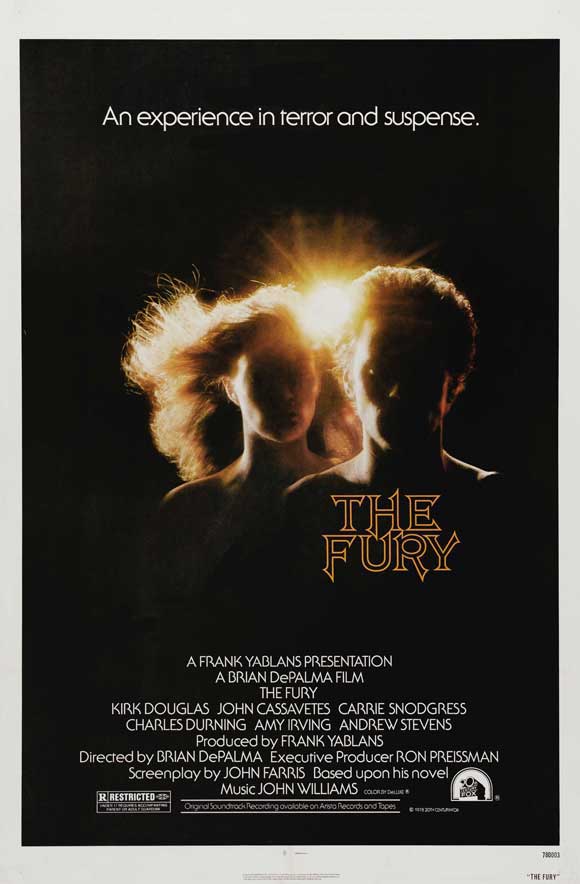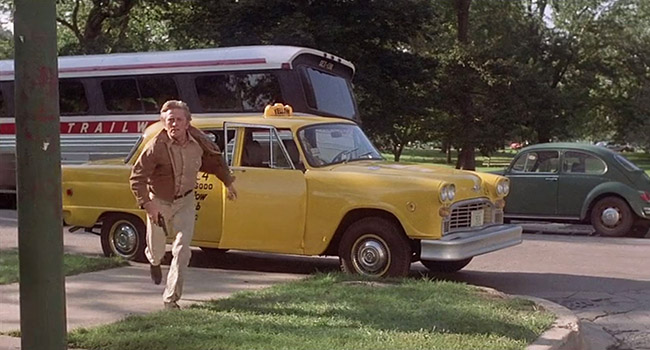
Brian De Palma followed his hit shocker Carrie (1976) with another exploration of telekinesis and its violent manifestations, the operatic and ambitious genre hybrid The Fury (1978). Anticipating David Cronenberg’s Scanners (1981), The Fury follows two young adults with powerful psychic abilities and the secret government agency which seeks to develop and harness their powers. Interest in ESP and other aspects of the paranormal were at their height in the 70’s, and De Palma layers metaphysics into a plot in league with the paranoid political thrillers of the decade. But The Fury is also a science fiction movie, a satire, a caper, and a gory horror film, all rolled into one odd package. Although adapted by author John Farris from his own novel (which became, in print, a series), one gets the feeling that De Palma is less concerned with the characters and themes than in the many opportunities for bravura cinematic showstoppers. You could separate The Fury into clips of these scenes and suggest a more sensational thriller than the whole actually provides. But that doesn’t mean it’s not worth seeing at least once, given its ambitious scope, excellent cast, and a talented director at play in a big budget sandbox.
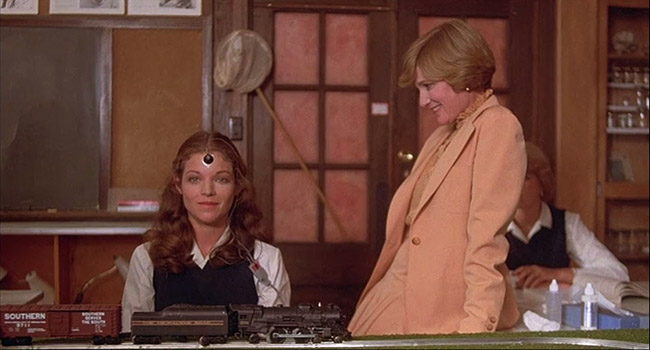
Gillian (Amy Irving) tests her psychic abilities on a model train.
Amy Irving (Carrie) plays the lead character, a psychic teenager named Gillian, although the film takes its sweet time introducing her. Instead, De Palma opens with some father-son bonding on a beach which a helpful title card says is in the “Mid East.” Peter Sandza (Kirk Douglas, still looking very fit and showing it off) competes with his son Robin (Andrew Stevens, future Cinemax star) in a swimming race under the eyes of Peter’s CIA cohort, the smarmy Ben Childress (John Cassavetes – in it for the money). Arab gunmen – you know, from the “Mid East” – open fire at Peter, and a shootout ensues. Robin witnesses his father’s escape attempt on a motorboat end in a dramatic explosion, but unbeknownst to Robin, his father survives. Peter discovers that Childress was behind his assassination attempt, and retaliates by shooting him in the arm. Peter will later describe what he did to Childress’ limb in some goofy dialogue delivered with full-on Kirk Douglas intensity: “I killed it. With a machine gun!” Believing his father killed, Robin accepts Ben’s offer to participate in a top secret government program to develop his psychic abilities. Meanwhile, in what feels like a completely different film, Gillian begins to realize she can read the minds of her classmates (in a nice little scene, she accidentally reveals one girl’s secret pregnancy), but inflicting spontaneous bleeding in the process. Dr. McKeever (Charles Durning, Tootsie), an instructor experimenting with telepathy and telekinesis, invites Gillian to the Paragon Institute, where he and Hester (Carrie Snodgress, Diary of a Mad Housewife) proceed with studying the limits of her talents. McKeever is actually working with Childress, and Gillian begins seeing visions of Robin, his studies and his growing mental instability. Meanwhile-meanwhile, in a spy adventure, Robin’s dad dodges Childress’ assassins with quips and shootouts, until finally he joins forces with Gillian to rescue his son, and the various threads merge like a ball of yarn after a cat’s been at it.
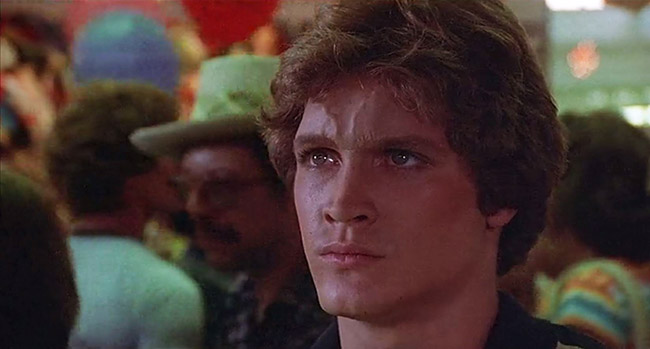
Robin (Andrew Stevens) unleashes deadly destruction at an amusement park.
Spoilers ahead – for a sense of the film’s abundant flaws and surprisingly delightful virtues, consider the final scenes of The Fury. In the climax, Andrew Stevens’ Robin tortures and kills the woman (Fiona Lewis, Lisztomania) who has been using sex to pacify him during his internment. Because these two haven’t been established apart from some brief, chilly scenes together, we don’t care about either of these characters – and yet it’s an effectively horrifying scene, with Lewis hovering near the ceiling, dripping blood while a vein bulges in Stevens’ head. (Again, this is Scanners before there was a Scanners.) When Kirk Douglas arrives, he lets his son fall to his death off the roof, and then he leaps to his death in suicidal grief. I shrugged. A few minutes later, Amy Irving uses her new “Fury” power to blow John Cassavetes to pieces. The convincing dummy representing Cassavetes is shot from multiple high speed cameras and took almost a week to film, since the first attempt didn’t take, and fake blood needed to be scrubbed from the set. To call the finished scene spectacular is an understatement. The same goes for a very De Palma-esque setpiece in an indoor amusement park, where the insane Stevens causes a carriage to break free from a spinning ride, flying through the air and crashing into a restaurant. You’ll want to rewind and watch it again.
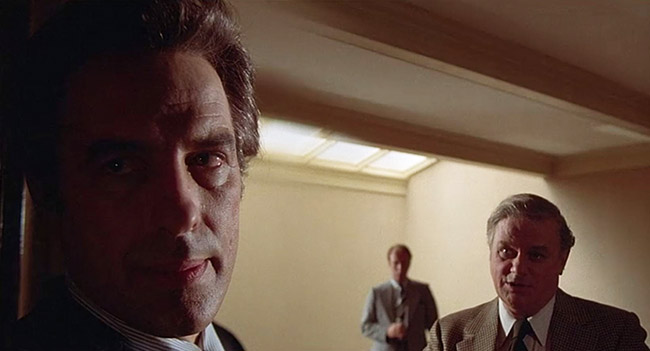
Ben Childress (John Cassavetes) meets with Dr. McKeever (Charles Durning).
Does it matter if huge chunks of the film don’t make sense, are poorly explained, or are nonsensically bigoted (here come some more Arabs in sunglasses and head scarves, because a body count is needed)? It’s worth it for the occasional De Palma masterstroke, such as Gillian’s and Hester’s escape from Dr. McKeever’s home, which works down a list of De Palma signatures: slow motion (check) set to melodramatic music (check) with parallel elements in motion (check) and unfolding with tragic, bloody death (check). Also pay attention to the score by John Williams in this scene. (Williams had just come off Star Wars and Close Encounters of the Third Kind, and would score Superman the same year.) It begins triumphant – even a bit cheesy, I think – to match the emotions of Gillian and Hester breaking free of the home and running into the street. Gradually, gracefully, it turns harrowing and tragic. Williams’ work on the film’s title music is particularly impressive, finding a main theme that actually suits all of The Fury‘s widely varied styles and moods. Now that’s an achievement.
